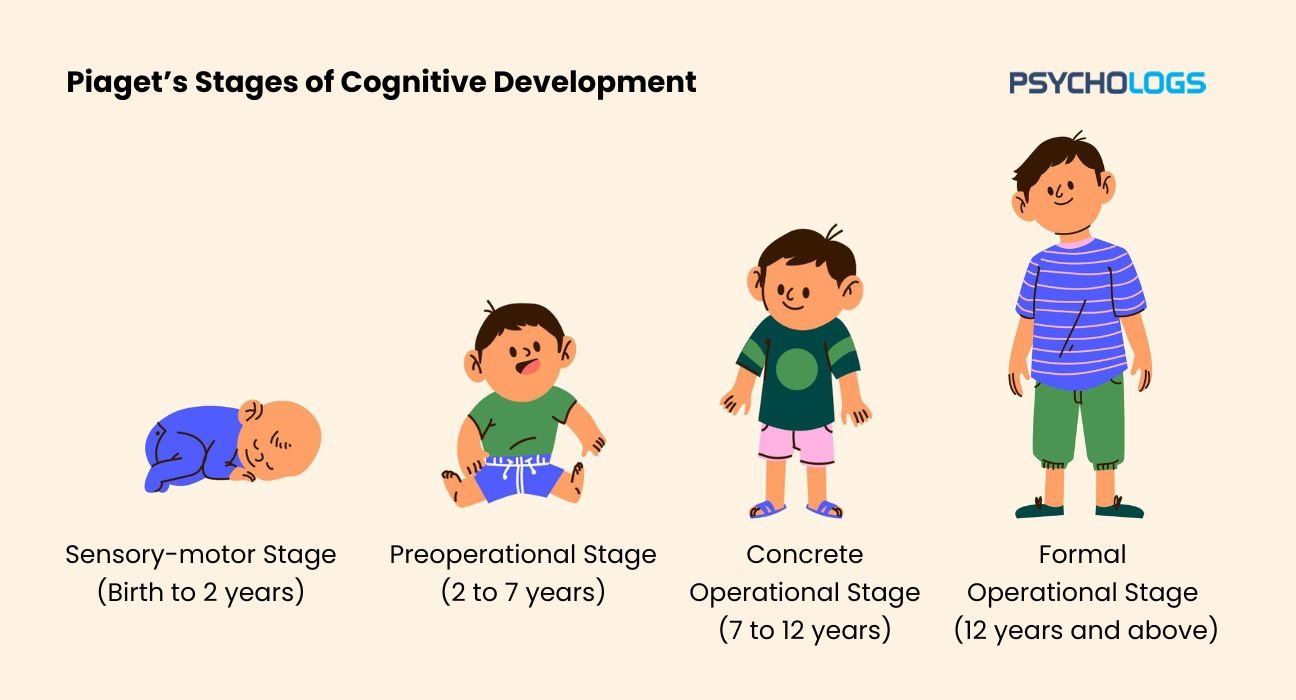Jean Piaget (1896-1980), renowned as the Father of Child Psychology, is well-known for his contributions to this field. Although he began his career studying molluscs, soon his focus shifted to development and cognition. He was an intellectual child right from the beginning, as evident from one of his research published when he was merely 11 years old. He worked closely with Alfred Binet and Theodore Simon, who contributed in the area of Intelligence. This experience ignited his keen interest in understanding how children think and learn, which led him to develop a theory that transformed the field of cognitive development.


History
One of the main sources of data for Piaget’s study was based on actual observations of children, which provided the foundation for the stages of cognitive development given by him. This theory explains the development of human cognitive ability from birth to adulthood, as well as the development of specific cognitive abilities related to a particular age group (Piaget, 1954).
Piaget vs Vygotsky
Both belonging to the domain of Developmental Psychology, Jean Piaget and another influential figure, Lev Vygotsky differed in their views.
Piaget, a constructivist, emphasised the process of children investigating, exploring, discovering, and rediscovering meaning in their surroundings. His approach emphasises universal stages of cognitive growth from infancy to adolescence while acknowledging the importance of social influences such as parents and peers. On the other hand, Vygotsky, an interactionist, believed that understanding development demands a social-historical perspective. His study emphasises the importance of early childhood thinking and its relationship to language and speech development.
These quotes by Piaget and Vygotsky can help understand the primary difference in their views—
“Every time we teach a child something, we keep him from inventing it himself. On the other hand, that which we allow him to discover for himself will remain with him visible for the rest of his life.” — Jean Piaget
“What a child can do in cooperation today, he can do alone tomorrow.” — Lev Vygotsky
In short, while Piaget emphasised individual exploration and discovery as important for cognitive development, Vygotsky stressed the importance of social interactions and cooperative learning in shaping a child’s intellectual development.


Stages of Cognitive Development Theory
According to Piaget, thinking and cognitive abilities evolve in four stages—
Sensory-motor Stage (Birth to 2 years)
During this stage, infants learn about the world through their senses and motor activities. This stage is initially marked by a lack of object permanence. For them, what is out of sight is out of mind. By 8 months of age, they begin to understand the concept of object permanence and know that objects continue to exist even when they are not visible. Infants begin by using reflexes, which gradually progress into intentional actions as they coordinate sensory input with motor movements. They learn through trial and error. For instance, by accidentally burning their fingers by touching a candle flame a few times, they eventually learn that fire is a dangerous element. By the end of this stage, toddlers are capable of forming mental representations of objects, and they begin to acquire a sense of self as distinct from their environment.
Preoperational Stage (2 to 7 years)
In this stage, the child experiences rapid development of language and symbolic thinking. This is evident when children draw figures to represent people, trees, houses, and other objects. However, they struggle with egocentrism: finding it difficult to see things from other people’s perspectives. They also exhibit animism: the belief that inanimate objects have lifelike properties.
For example, a parent tries to console a child by beating the floor if they fall! Children in this stage have difficulty understanding the concept of conservation, where quantity remains the same despite changes in shape. They start using symbols like words and images to represent objects. Their thinking is abstract and intuitive, and not yet logical or organised.
Concrete Operational Stage (7 to 12 years)
This stage is characterised by the development of logical thinking about concrete objects. Children in this stage understand the concepts of conservation, classification and spatial reasoning. They gain the ability to perform basic mental operations such as addition and subtraction on concrete objects. Children begin to understand the concept of reversibility, recognizing that objects can be modified and then restored to their original state.
One well-known test that demonstrates this stage uses two similar clay balls. An experimenter rolls one ball into a long, thin strip while keeping the other in its original form. When asked which has more clay, children aged 7 or above tend to be able to mentally reverse the transition and conclude that both have the same quantity. This represents a significant progress in cognitive development.
Formal Operational Stage (12 years and above)
The last stage marks the development of abstract and hypothetical thinking. Adolescents and adults in this stage can systematically plan and solve problems, think about abstract concepts such as justice and freedom, and engage in logical thinking and deductive reasoning. They can consider multiple perspectives and hypothetical scenarios, which adds to their problem-solving skills. Individuals develop the ability to think about future possibilities and engage in long-term planning. They also develop meta-cognition, which allows individuals to reflect on their thought processes and understand their cognitive abilities.
Important Cognitive Development Concepts
Schemas
These are building blocks of knowledge. According to Piaget, schemas are coherent, repeating action sequences that structure knowledge of objects, behaviours, and abstract concepts. For example, a schema for dining at a restaurant may comprise behaviours such as looking at the menu, ordering, eating, and paying the bill. Newborns have natural schemas, such as sucking and grasping reflexes. Schemas provide the basis for future cognitive development and enable them to interact with the world around them.
Equilibration
Piaget described organising, integrating, and accommodating as a complex act of balancing. Equilibration is the act of searching for a balance. It entails transitioning from a state of cognitive disequilibrium, in which new information conflicts with current schemas, to one of equilibrium, in which schemas change to incorporate the new information. Equilibration is achieved through adaptation— a process of gradually modifying existing schemes to take into account changes or discrepancies between what is known and what is being experienced. Adaptation is a two-part process that includes assimilation and accommodation.
Assimilation
It is the process by which individuals integrate new information into pre-existing schemas. When children have new experiences, they try to fit them into their existing understanding. For example, a child who is familiar with dogs may encounter a cat for the first time and refer to it as a dog, using their current dog schema to the unfamiliar animal. Assimilation allows for continuity and stability in understanding the world, even when new information is received.
Accommodation
It occurs when new information cannot fit into existing schemas, necessitating changes to those schemas. This process involves modifying existing schemas or creating new ones to add new information. For example, the child who first misidentified a cat as a dog will gradually learn to differentiate between the two animals and establish distinct schemas for each. Accommodation is critical for cognitive development and adapting to new situations.
Related: Assimilation and Accommodation
Takeaway
While Piaget saw development as a series of universal stages driven by the child’s independent exploration, Vygotsky emphasised the social and cultural environments of learning, with development being driven by social interactions and mediated by language. Understanding these stages can help parents and educators to better assist children’s cognitive development by presenting appropriate challenges and creating environments that encourage exploration and learning. Piaget’s theory has been extensively used in developing teaching and learning interventions. It has several educational implications. A Piagetian classroom encourages exploration learning, is sensitive to children’s readiness to learn, and accepts individual differences.
FAQs
1. What are the main differences between Piaget’s and Vygotsky’s theories of cognitive development?
While Piaget saw development as a series of universal stages driven by the child’s independent exploration, Vygotsky emphasised upon the role of social and cultural environments in learning, with development being driven by social interactions and mediated by language.
2. What is object permanence, as mentioned under the stages of cognitive development?
A concept developed by Jean Piaget, Object Permanence refers to a child’s ability to know that objects continue to exist even when they are not visible. For example, children during the middle of the sensory-motor stage. The peekaboo game is the classic example of this concept.
3. How do assimilation and accommodation contribute to cognitive development?
Assimilation incorporates new knowledge into current schemas, whereas accommodation alters or generates new schemas to include new information, facilitating cognitive adaptability and growth.
4. How can a parent or an educator use Piaget’s theory of Cognitive Development to facilitate learning?
Parents and educators can enhance children’s cognitive development by giving age-appropriate tasks and creating an atmosphere that stimulates exploration and discovery. For example, children in the sensory-motor stage can be engaged with sensory-rich activities like textured toys, various forms of auditory and visual sensations, and learn through trial and error.
References +
- Berk, L. E. (2006). Child Development (7th ed.). Pearson. https://drive.google.com/file/d/1pRycSN0kflyc9eU2w9xSFFJgXd9HN1_z/view
- Cherry, K. C. (2024). Piaget’s 4 Stages of Cognitive Development Explained. Verywell Mind. https://www.verywellmind.com/piagets-stages-of-cognitive-development-2795457
- Newman, B. M., & Newman, P. R. (2012). Development Through Life: A Psychosocial Approach (11th ed.). Wadsworth, Cengage Learning.
- Richland, L. E., Frausel, R. R., & Begolli, K. (2016). Cognitive development. In Harold L. Miller (Ed.), The SAGE Encyclopedia of Theory in Psychology (pp. 143–146). SAGE Publications, Inc. https://doi.org/10.4135/9781483346274.n50







Leave feedback about this